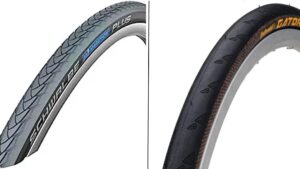How To Select The Best Wheels For Your Mountain Bike

Dive into the world of mountain bike wheel selection, exploring traction essentials, tire patterns, and materials for an optimized riding experience.
*This article may contain affiliate ads that help to support this site*
Mountain biking’s thrill lies not just in the ride, but in the connection between rider and terrain—where every turn, jump, and descent demands precision. Central to this dynamic is the often-overlooked hero: the mountain bike wheel. In this exploration, we uncover the critical role of wheel selection in elevating your biking experience. Traction, the unsung hero of every trail, takes center stage. As we delve into the nuances of mountain bike wheel choices, we’ll unlock the secrets to finding the perfect balance between speed, control, and safety. Join us on this journey to navigate the diverse world of mountain bike wheels and conquer terrains with confidence.
Understanding Traction
Traction is the unspoken language between your mountain bike and the trail, defining the level of grip and control you have over diverse terrains. In the world of mountain biking, traction is the key to unlocking your bike’s full potential. Simply put, it’s the friction between the tire and the ground that determines how well your bike adheres to the trail surface.
The significance of traction becomes evident in every twist, turn, ascent, and descent. Insufficient traction can compromise stability, making it harder to navigate challenging obstacles, while excessive traction might impede speed on smoother sections. Achieving the right balance is akin to mastering a delicate dance with the trail, requiring a harmonious interplay between tire design, wheel size, and trail conditions.
Tires play a pivotal role in traction, with their tread patterns and rubber compounds dictating performance. Tread patterns are designed to bite into specific types of terrain, offering varying levels of grip. For example, aggressive, deep treads excel in muddy conditions, providing enhanced traction, while smoother treads are suitable for hard-packed trails where reduced rolling resistance is essential.
Understanding traction is not just about technicalities; it’s about maximizing your biking experience. The more attuned your wheels are to the trail beneath, the more confidently you can navigate the twists and turns that define the mountain biking adventure.
Types Of Mountain Bike Wheels
Choosing the right mountain bike wheels involves navigating through a landscape of options, with each type catering to specific riding preferences and terrains. The most common wheel sizes are 26-inch, 27.5-inch, and 29-inch, each offering a unique set of advantages.
26-inch wheels: Once a standard, these wheels are known for their agility and maneuverability. They accelerate quickly and are easy to handle, making them a popular choice for technical trails that demand quick turns and rapid changes in direction. However, they may not roll as smoothly over obstacles as larger wheels.
27.5-inch wheels: These wheels strike a balance between the nimbleness of 26-inch wheels and the enhanced roll-over capabilities of 29-inch wheels. They are versatile, providing good traction and stability across various terrains. This middle-ground option has gained popularity among riders seeking a compromise between agility and momentum.
29-inch wheels: Characterized by their larger diameter, these wheels excel in rolling over obstacles with ease. They maintain momentum well and offer enhanced stability, making them suitable for cross-country and endurance riding. However, they may feel less responsive in tight, technical sections due to their increased circumference.
When deciding on wheel size, consider your riding style and the terrain you frequent. If you’re a cross-country rider covering long distances, 29-inch wheels may be advantageous. For technical trails that demand quick maneuvers, 26-inch wheels could be the ideal choice. Riders often find the 27.5-inch wheels to be a versatile compromise, offering a well-rounded experience across different riding conditions.
Ultimately, the choice between wheel sizes involves trade-offs, and understanding these trade-offs is crucial for tailoring your mountain bike to your specific preferences and the challenges of the trails you love to conquer.
Tire Tread Patterns
Tire tread patterns are the fingerprints of a mountain bike wheel, leaving a distinct mark on its performance across various terrains. The design of the tread plays a pivotal role in determining the level of traction and control a rider experiences on the trail.
For muddy and loose terrains, aggressive tread patterns are paramount. These patterns typically feature deep lugs and spaced-out knobs, allowing the tire to bite into the soft ground and provide much-needed grip. The protruding edges of the tread dig into the terrain, preventing slippage and ensuring stability even in challenging conditions.
Conversely, smoother and less aggressive tread patterns are suitable for hard-packed trails. These patterns reduce rolling resistance, allowing the bike to glide more efficiently over surfaces with less grip. The decreased friction enables riders to maintain higher speeds on smoother terrains without compromising control.
Some tires feature a combination of tread patterns, with more aggressive designs on the front tire for steering control and less aggressive patterns on the rear tire for better speed maintenance. This hybrid approach optimizes the strengths of different tread designs to enhance overall performance.
Moreover, the rubber compound of the tire also influences traction. Softer compounds provide better grip but wear out faster, while harder compounds offer durability at the cost of slightly reduced traction.
When selecting a tire tread pattern, consider the predominant trail conditions you encounter. A tire designed for mud won’t perform as well on hard-packed trails and vice versa. By aligning your tire’s tread pattern with your typical riding environment, you ensure that your mountain bike maintains optimal traction and control, enhancing your overall biking experience.

Hide A Bike Kit
Is your garage starting to become a mess? Save space by storing your bikes flat against the ceiling.
Wheel Materials And Construction
The materials and construction of mountain bike wheels play a crucial role in determining their performance characteristics, including weight, durability, and shock absorption. Two primary materials dominate the mountain biking scene: aluminum and carbon fiber.
Aluminum Wheels: Aluminum wheels are popular for their affordability, durability, and versatility. They offer a good balance between strength and weight, making them suitable for a wide range of riders. While slightly heavier than their carbon fiber counterparts, aluminum wheels are often preferred by riders who prioritize durability and cost-effectiveness.
Carbon Fiber Wheels: Carbon fiber wheels are the premium choice, prized for their lightweight nature and superior strength. They reduce rotational weight, enhancing a bike’s acceleration and maneuverability. Carbon fiber also has the added benefit of absorbing vibrations from the trail, providing a smoother ride. However, this performance boost comes at a higher price point, making carbon fiber wheels a choice for riders seeking the utmost in performance and willing to invest accordingly.
Rim Width: In addition to material, rim width is a critical factor influencing a wheel’s performance. Wider rims provide better support for the tire, allowing it to maintain its shape in corners and improve overall stability. They also offer increased traction and control, especially at lower tire pressures. Narrower rims, on the other hand, are often lighter and can provide a more responsive feel, suitable for certain riding styles.
Understanding the trade-offs between aluminum and carbon fiber, as well as the impact of rim width, is essential for tailoring your wheel choice to your specific needs. Whether you prioritize durability, weight, or a balance of both, the material and construction of your mountain bike wheels significantly contribute to your overall riding experience.
Riding Style And Terrain
Selecting the ideal mountain bike wheels isn’t a one-size-fits-all endeavor; it hinges on aligning your choice with your riding style and the diverse terrains you navigate. Your individual preferences and the conditions of the trails you frequent should guide this decision-making process.
Downhill vs. Cross-Country: For downhill enthusiasts tackling rugged descents and technical trails, durability and stability take precedence. Robust wheels with wider rims provide the necessary support for the aggressive nature of downhill riding, ensuring control and resilience against impacts. Conversely, cross-country riders seeking agility and speed on varied terrains may lean towards lighter wheels, prioritizing maneuverability and quick acceleration.
Trail-Specific Considerations: Consider the specific characteristics of the trails you frequent. If your rides encompass a mix of terrains, a versatile wheel choice, such as 27.5-inch wheels, might strike an optimal balance. Alternatively, if you predominantly navigate through challenging, rocky terrain, a combination of durable construction and aggressive tread patterns becomes paramount.
Climate and Weather Factors: Environmental conditions also influence wheel selection. In wet and muddy environments, deep-treaded tires offer enhanced grip, while in dry, hard-packed conditions, a less aggressive tread may suffice. Additionally, the weight of the wheel can impact your riding experience, with lighter wheels favored for climbing-intensive trails and heavier wheels for downhill stability.
By tailoring your wheel selection to your unique riding preferences and the terrains you conquer, you ensure that your mountain bike becomes an extension of your style, enhancing both control and enjoyment on every trail.

Hide-A-Bike Installation Guide
If you want to put together a Hide-A-Bike kit for yourself, just download these easy to follow, step-by-step directions, complete with a full hardware and parts list.
Conclusion
In the intricate world of mountain biking, where the terrain is as diverse as the riders themselves, choosing the right wheel is a decision that reverberates through every trail conquered. Traction, the silent conductor of this symphony, is finely tuned by the selection of wheel size, tread pattern, and material. Whether you’re navigating treacherous descents or mastering cross-country trails, understanding the nuances of wheel selection empowers you to tailor your ride. Consider your riding style, the terrains you traverse, and the balance between durability and weight. With the perfect wheels beneath you, each trail becomes not just a challenge but a canvas for your personalized biking experience.
Share This Article With A Friend
Did You Read This Whole Article?

You deserve a gift! Enter your email to receive a FREE copy of the Hide-A-Bike Installation Guide! And once a month we will send you a newsletter with the best deals on the internet for bicycle gear and accessories.
About Hide A Bike

Save space by keeping your bike flat against the ceiling with the original easy and convenient bicycle storage solution.
Thank You For Visiting!

You deserve a gift! Enter your email to receive a FREE copy of the Hide-A-Bike Installation guide. And once a month we will send you a newsletter with links to our best finds on bicycle gear and accessories.
Share This Article:
Most Popular Articles:
Article Categories:
Related Articles:

How Wheel Shape Impacts Cycling Speed And Aerodynamics

Demystifying The World Of Carbon Fiber Wheels






